If you’re an event planner operating in the European Union, you’ve probably come across the requirements for e-invoicing. Electronic invoicing is now mandatory for transactions involving public authorities in many EU countries.
For those unfamiliar, European e-invoicing is a project gradually pushing companies to transition all invoicing to the digital realm. This goes beyond just replacing paper invoices with .pdf files. The initiative introduces a government-controlled online portal that stores all e-invoices. The primary goal is to assist EU members in better tax collection, especially regarding VAT, while also reducing human errors and invoicing-related costs for both private and public entities.
Although specific details of the process may differ between countries, the general rule is simple: invoices will be uploaded to a government-designed and operated online portal. They will adhere to a specific format and be accompanied by the certified electronic signature of the issuer. The recipient will access the invoice on the same portal, enhancing transparency, reducing fraud, and accelerating payment speed.
How Will European e-Invoicing Affect Event Planners?
If you operate in a European Union country, sooner or later, you’ll be impacted by the e-invoicing requirement. Initially mandatory for transactions with public administrations, it’s now expanding to cover all B2B transactions. Soon, if you sell event tickets to a company, your invoice will need to go through a digital portal. Dealing with hundreds or thousands of such invoices, the last thing you want is to manually handle this process.
Luckily, we’re here to help you. Oveit is a tool designed not only to fully automate repetitive tasks but also to seamlessly communicate with third-party apps. As you focus on creating memorable events, let our software solutions handle the crucial yet mundane tasks.
Our APIs enable easy integration with your preferred invoicing system, one that aligns with the national e-invoicing platform. Whenever someone places an order, Oveit generates an invoice on your behalf. Moreover, it can transmit that invoice (or batches of invoices) to a third-party solution, simplifying the process of importing them into the government portal.
Changes for Event Planners in Europe
Soon, all event planners throughout Europe will need to adhere to e-invoicing regulations. This new initiative aims to assist authorities in more effectively collecting VAT while reducing the environmental impact and helping companies simplify their invoicing processes.
Shortly, you’ll be required to transition B2B invoices into a government-controlled digital environment. The good news is, you won’t have to handle this manually. Fortunately, available software solutions allow you to automate the entire process effortlessly.
